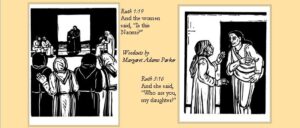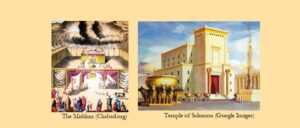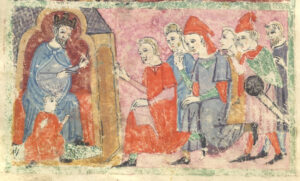Parashat Ki Tisa is a Song of both longing and danger. To understand the longing, we need to look back. Previous to our parsha, the people had been witness to the awesome presence of God on Har Sinai, to thunder, smoke, lightening, and shofar blasts when God revealed God’s commandments (Ex. 19:16-20:18). This had followed on the miraculous parting of the Sea of Reeds to permit the Israelites to escape from their former slave-masters in Egypt (Ex. 14-15).
When Moses arrives at the top of Mt Sinai to accept the stone tablets, entering the cloud of God’s presence (Ex 24:18), God gives instructions for Moses to pass to the people regarding the building of the sanctuary and the priestly vestments and consecrations. The instruction lasts for 40 days, while the children of Israel wait expectantly at the foot of Mount Sinai for Moses to return. They do not yet know that Moses will bring them a blueprint for building a Mikdash where God’s Shekhina שְׁכִינָה can dwell amongst them שכנתי. Ex 25:8 Let them make me a sanctuary וְעָשׂוּ לִי מִקְדָּשׁ וְשָׁכַנְתִּי בְּתֹוכָֽם Ve-asu li mikdash, Ve-shachanti be-tocham. But as the period of time is coming to an end, the people are restless and bewildered. They can remember how God appeared at the Sea of Reeds and on the mountain top, and we can readily imagine the sense of loss and of longing for God to return.
In their loneliness, they crave a holy presence, “for this Moshe, the man who brought us up from the land of Egypt, we do not know what has become of him!” (Ex 32.1 Everett Fox translation). They go to Aaron, brother of Moses, and say to him, “Make us a god who will go before us!” (Fox). There follows the well-known story of the creation of the golden calf from the gold rings of the people, and of the people eating, drinking, and dancing wildly around their creation. We may reasonably understand that the people are yearning, and that perhaps it is a quest for holy presence that leads them to create the golden calf, not the desire to blaspheme, to worship idols, or to turn against their God.
But herein lies the danger in Ki Tisa. When Moses discovers that the Israelites have created their own form of worship in his absence, he initially pleads with God to spare their lives and God does so. (Ex 32:7-14). However, when he descends among the people, Moses orders the Levites to assassinate 3,000 of the Israelites. (Ex. 32:26-28). Furthermore, although Moses successfully pleads with God not to destroy the people entirely (Ex. 32:31-34), nevertheless God sends a plague upon the people (Ex. 32:35). If the people were expressing longing for God, how do we understand a world in which they can be punished for doing so?
I would like to read the creation of the golden calf as the story of people who are yearning for God’s presence, and who do the best they can in their circumstances to fill that longing. Amichai Lau-Lavie in Torah Queeries sees their dancing around the calf as a “the shattering of the law,” as a triumph of human spirit and sexuality over the “yoke of silencing law.” But there is a real problem with either of these readings, and that is the punishment meted out by both Moses and God.
I propose to illuminate the sometimes sparse text by following the rabbinic tradition of reading the Song of Songs intertextually with the Torah. But fair warning, the Song illuminates the danger as well as the longing.
When God reveals God’s commandments, the people bear witness to the awesome and physical presence of God on Mt. Sinai, to thunder, smoke, lightening, and shofar blasts (Ex. 19:16-20:18). Aviva Zornberg comments “At the moment when God spoke at Sinai, a whole nation lost consciousness and regained it.” (The Murmuring Deep, pg 246). She quotes from Shemot Rabbah 29:3, which provides a good illustration of how the rabbis read Song of Songs with the Torah.
Levi said: Israel asked of God two things – that they should see His glory and hear His voice; and they did see His Glory and hear His voice, for it says, “And you said: Behold, God has shown us His glory and His greatness, and we have heard His voice out of the midst of the fire” (Deut. 5.21). But they had no strength to endure it, for when they came to Sinai and God revealed Himself to them, their souls took wing because He spoke with them, as it says, “My soul left me when he spoke” (Songs 5:6).
Zornberg suggests that the people are destabilized by “the shock of God’s voice.” Their souls have left them. And in this destabilized condition, it now appears to them that Moses has left them for good. Moses has learned from God that it will be possible (and necessary) for the Israelites to build a sanctuary, so that God may dwell amongst them. But the people do not yet know about this. Their souls have left them, and Moses has left them. They erect the golden calf.
When Moses descends from Sinai, the the Israelites are dancing around the calf. Joshua tells Moses that he hears the cry of war (kol milchamah). However, Moses hears the following:
Not the sound of crying out in triumph,
and not the sound of crying out in defeat.
A sound of crying out I hear. (Ex 32:18, translation Robert Alter)
Moses hears the people simply crying out, neither triumphant nor defeated. I read this as the people crying out from their souls, crying out for fulfillment, crying out for God’s presence. This may remind us of Hannah’s prayer where she pours out her bitter soul, her empty and longing soul, before God: I pour my soul out before YHWH וָאֶשְׁפֹּךְ אֶת-נַפְשִׁי, לִפְנֵי יְהוָה. . (1 Sam 1:15).
Like R. Levi, we can read Song of Songs, but here we read a little further in the verse and find how the singer felt when her soul left her, how she sought but could not find her lover, and begged for help to find him, as the Israelites sought and could not find Moses or God. In Chapter 5, the singer is called to the door by her beloved, but hesitates, and then
I opened to my beloved; but my beloved had turned away, and was gone. My soul failed me [left me] when he spoke. I sought him, but I could not find him; I called him, but he gave me no answer. (Song 5:6) I adjure you, O daughters of Jerusalem, if ye find my beloved, what will ye tell him? that I am love-sick. (Song 5:8)
As the lover called out, so too the Israelites call out with “the sound of crying out.” They don’t yet know about building a Mikdash, so they gravitate to the one thing which they know about that might bring God’s presence – the golden calf. In this reading, they do not have intent to blaspheme, to worship idols, or to turn against their God. Yet, if they are expressing their longing for God in creating the golden calf, it seems harsh that they must be punished. Is it for lack of faith? It still seems harsh, yet very much like a reflection of the real world.
Listen to the Song in conjunction with the punishment of people at Sinai:
And he [Moses] said unto them: ‘Thus says YHWH, the God of Israel: Put ye every man his sword upon his thigh, and go to and fro from gate to gate throughout the camp, and slay every man his brother, and every man his companion, and every man his neighbor. And the sons of Levi did according to the word of Moses; and there fell of the people that day about three thousand men. (Ex. 32:26-28).
And YHWH smote the people [with a plague], because they made the calf, which Aaron made (Ex. 32:35).
Immediately after the singer of the Song laments over not finding her lover, she says:
The watchmen that go about the city found me, they smote me, they wounded me; the keepers of the walls took away my mantle from me. (Song 5:7)
Who are these watchmen? It is surely dangerous to walk about the city when the very guardians of public safety are liable to beat the walker. Is the walker in a dream? Is she beaten because she is dreaming? Because she is yearning? Because the search she conducts for her lover does not fit with the societal norms [in this case, of male pursuing female]? The moment when the singer of the Song is beaten by the watchman, and the moment when the children of Israel are punished by God (and by Moses), are awful/awe-full moments. Their hearts were full of longing, and then, wham! There are other, and plentiful, times of joy, of success in finding. But punishments are troubling and remind us that the world, then and now, is not always a safe place in which to be out and to follow one’s heart.
Here is the text of Song 5:2-8
(2) I was asleep,
But my heart was wakeful.
Hark, my beloved knocks!
“Let me in, my own,
My darling, my faultless dove!
For my head is drenched with dew,
My locks with the damp of night.” (3) I had taken off my robe—
Was I to don it again?
I had bathed my feet—
Was I to soil them again? (4) My beloved took his hand off the latch,
And my heart was stirred for him. (5) I rose to let in my beloved;
My hands dripped myrrh—
My fingers, flowing myrrh—
Upon the handles of the bolt. (6) I opened the door for my beloved,
But my beloved had turned and gone.
I was faint because of what he said.
I sought, but found him not;
I called, but he did not answer. (7) I met the watchmen
Who patrol the town;
They struck me, they bruised me.
The guards of the walls
Stripped me of my mantle. (8) I adjure you, O maidens of Jerusalem!
If you meet my beloved, tell him this:
that I am faint with love.
About the banner:
On the left you can see the longing inherent in building the tabernacle in the desert. And when they are delayed, the people reach out for alternate worship, the golden calf on the right.
Picture on left: Building the Tabernacle http://www.rjews.net/gazeta/Photo/hram.php3?id=1
Picture on right: Carrying the Golden Calf. Fresco Hall of the Saints Borgia Apartments – Appartamento Borgia, Palazzi Vaticani Rome by PINTURICCHIO 1454 -1513 Vatican Italy Frescoes



